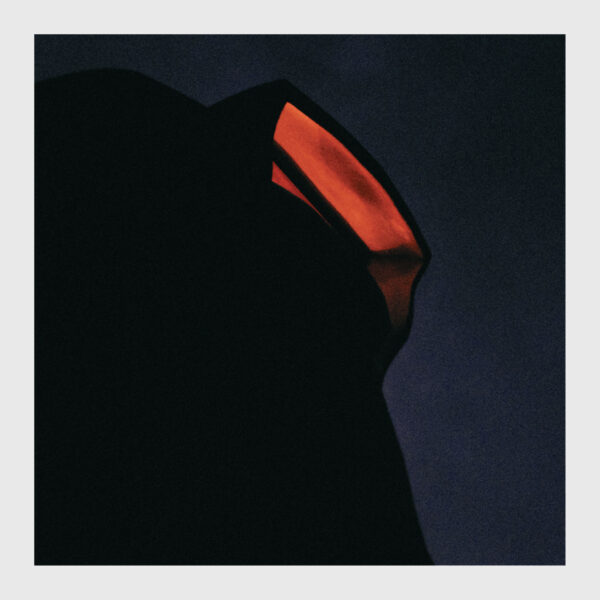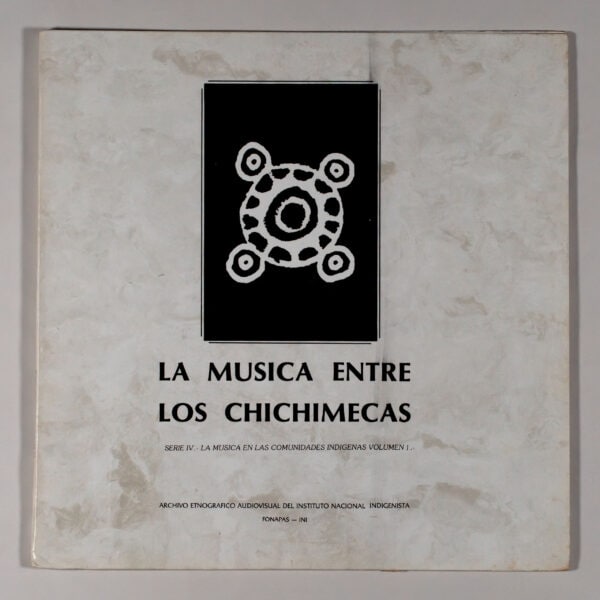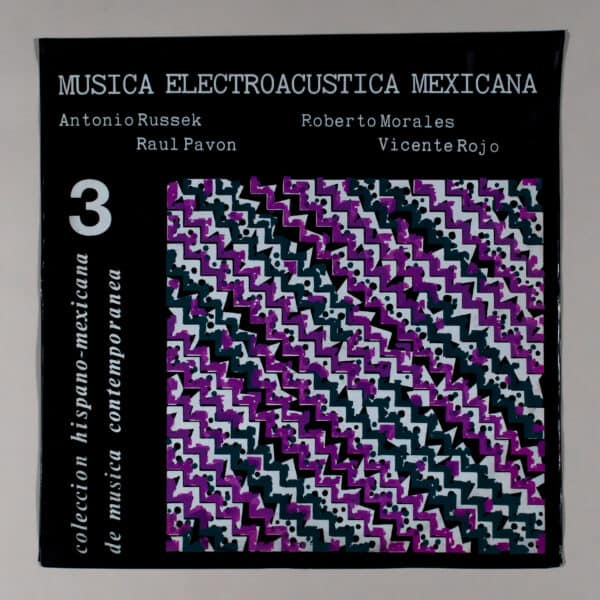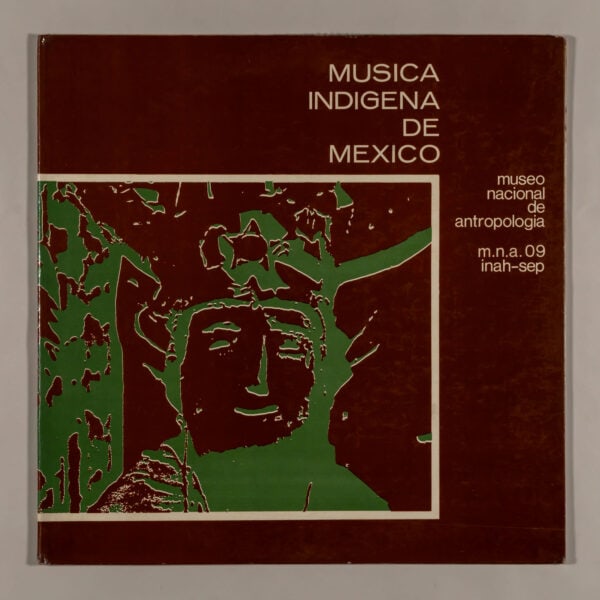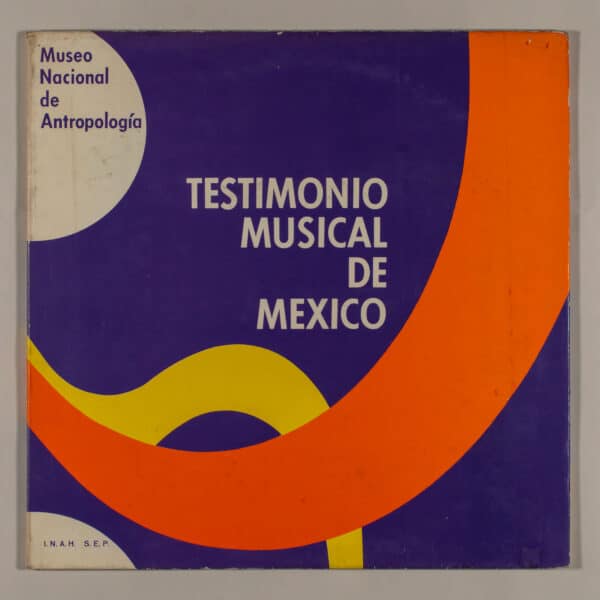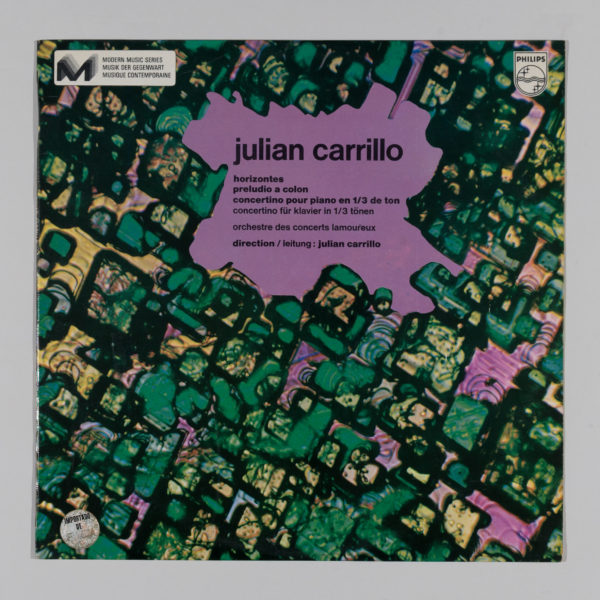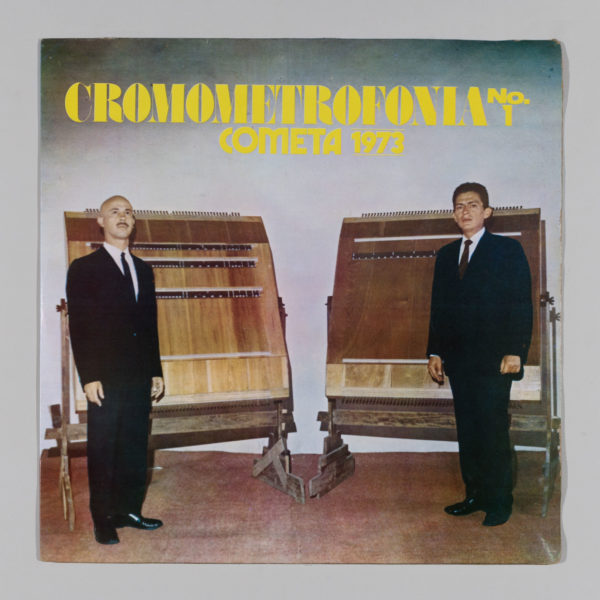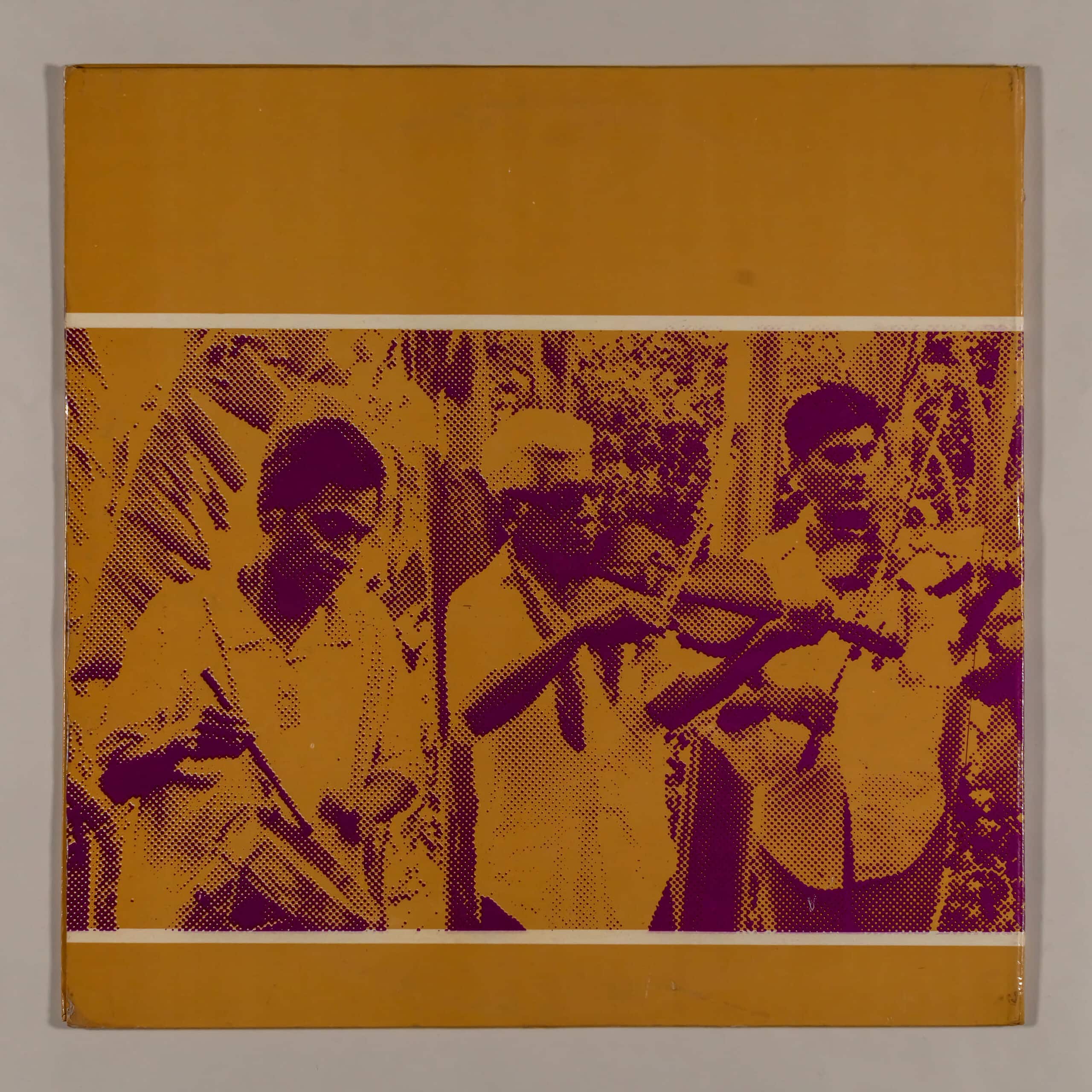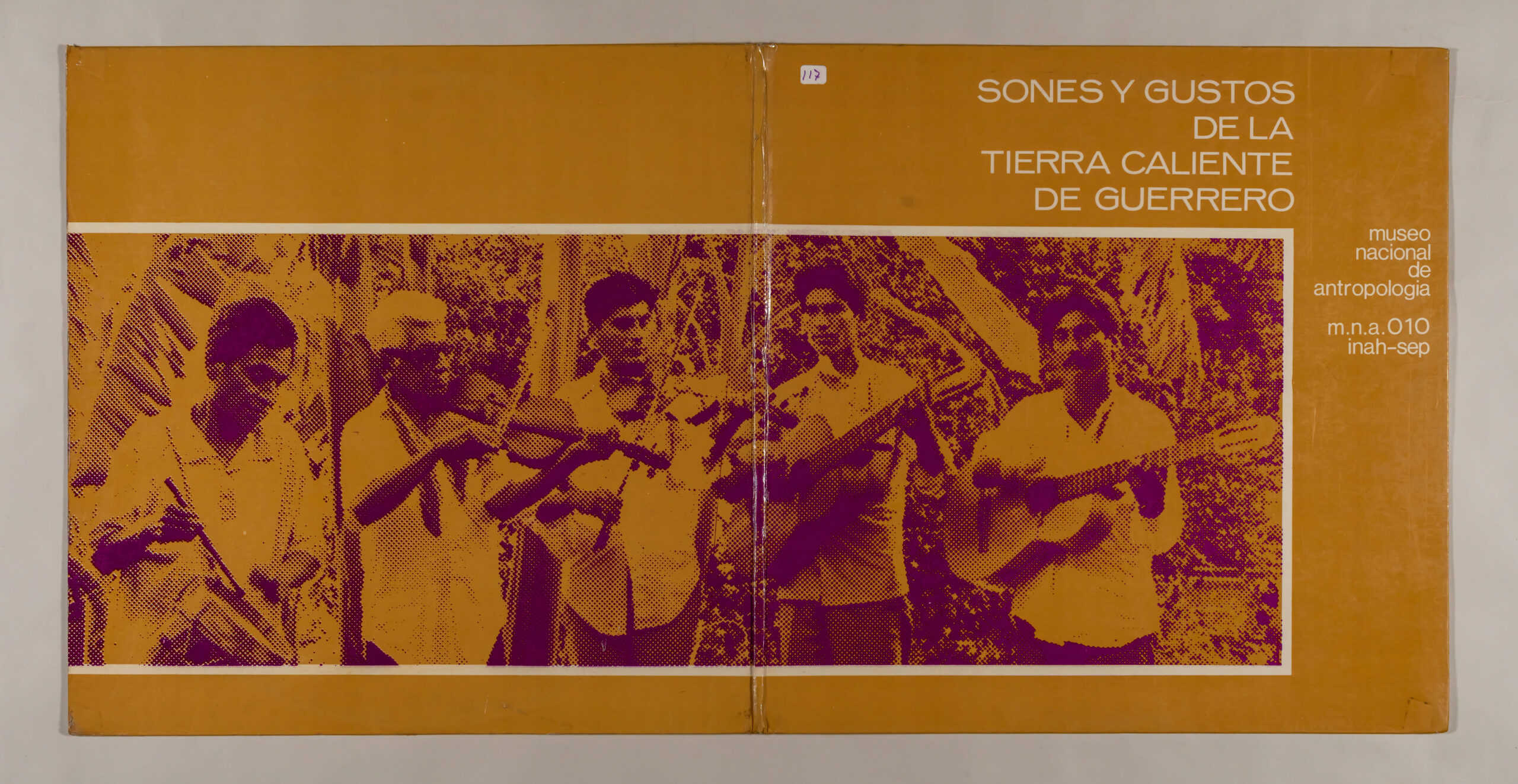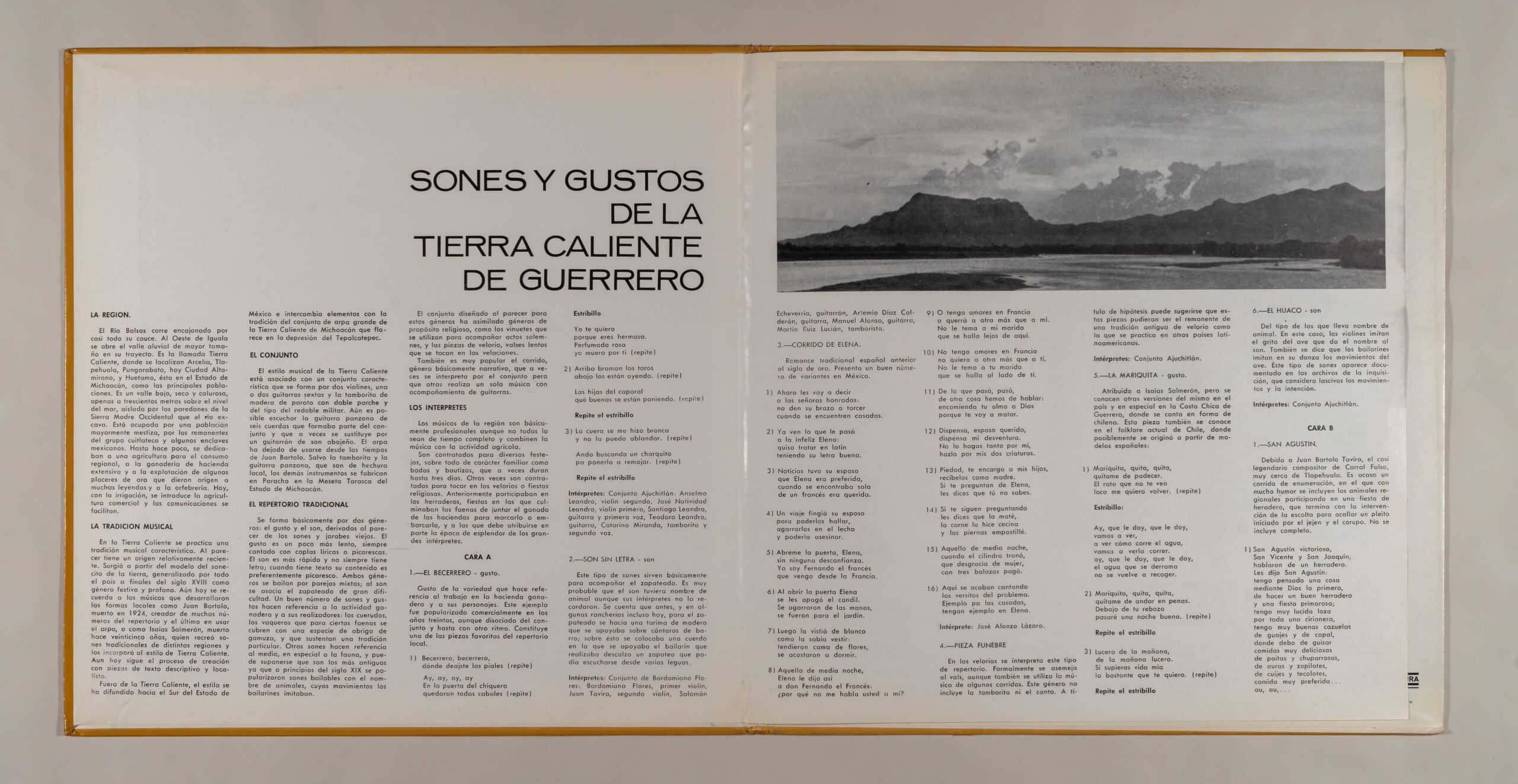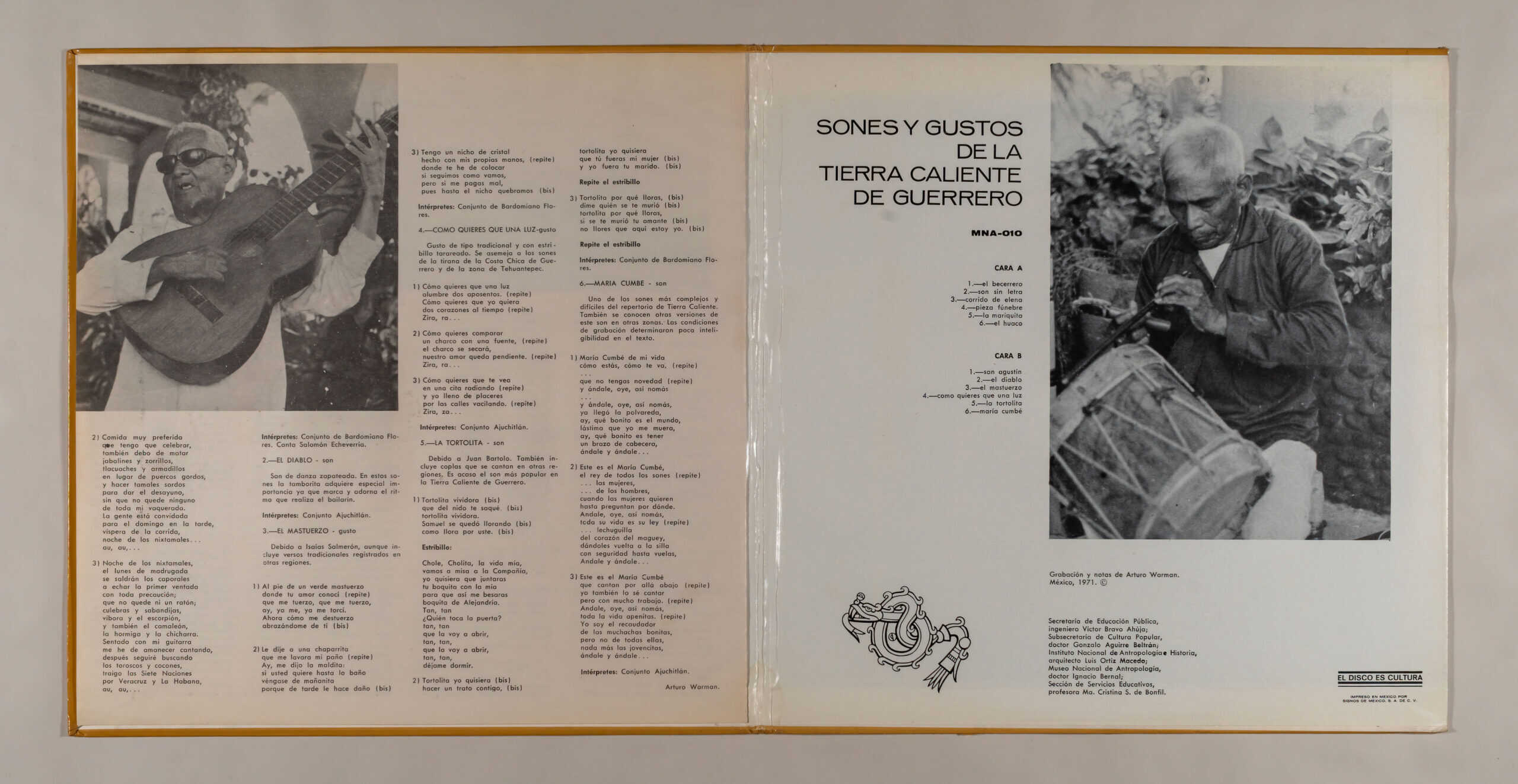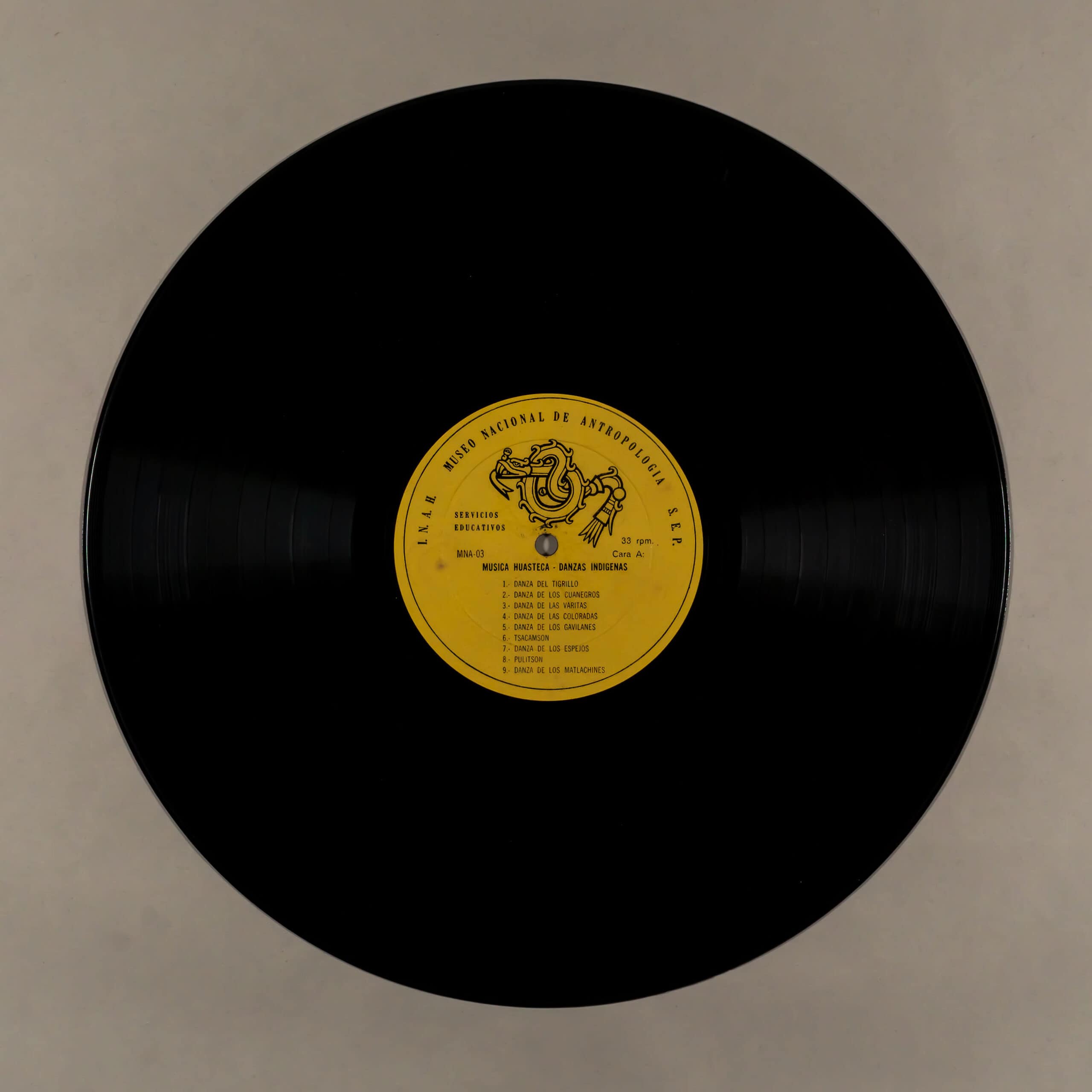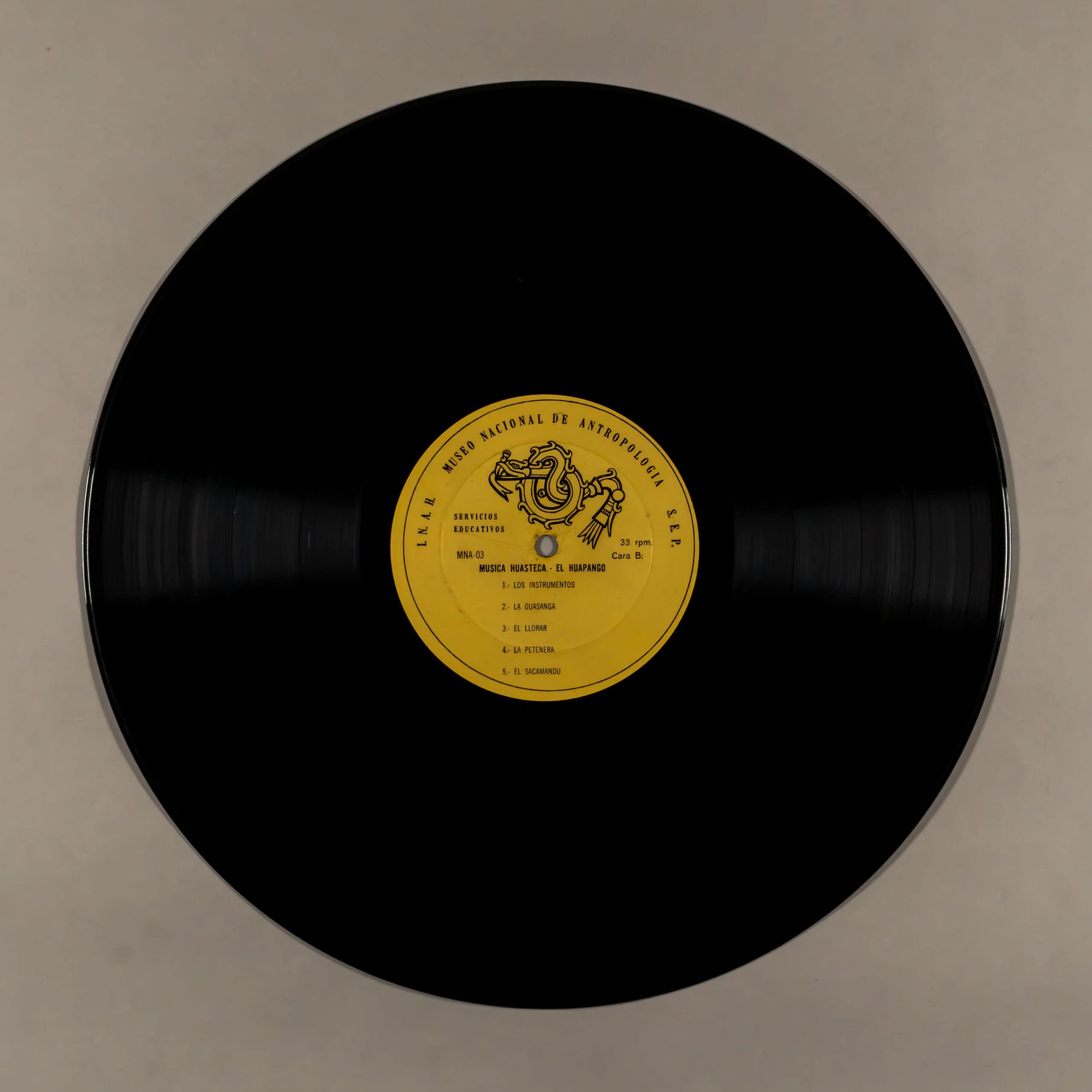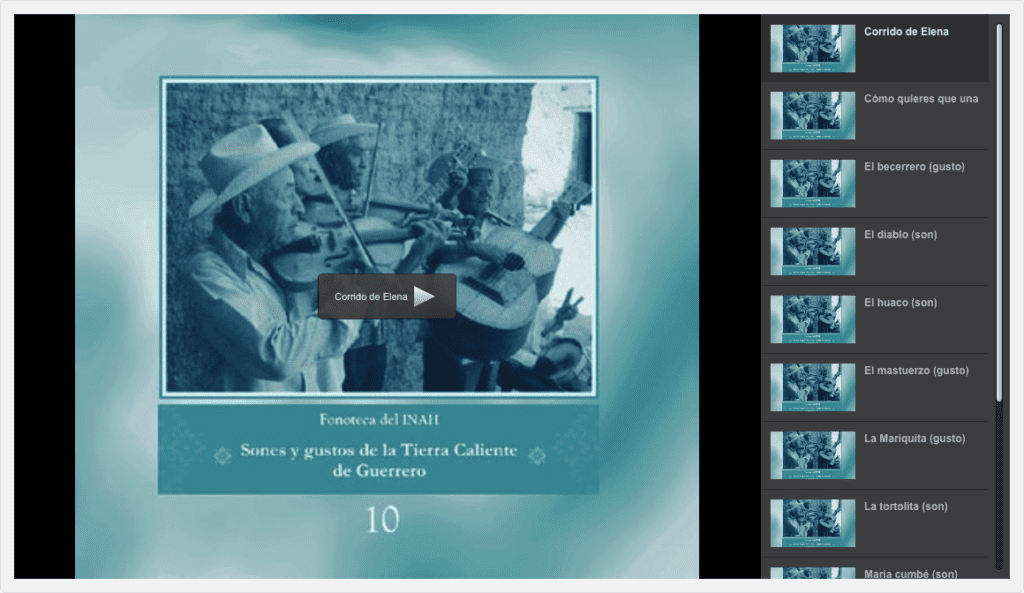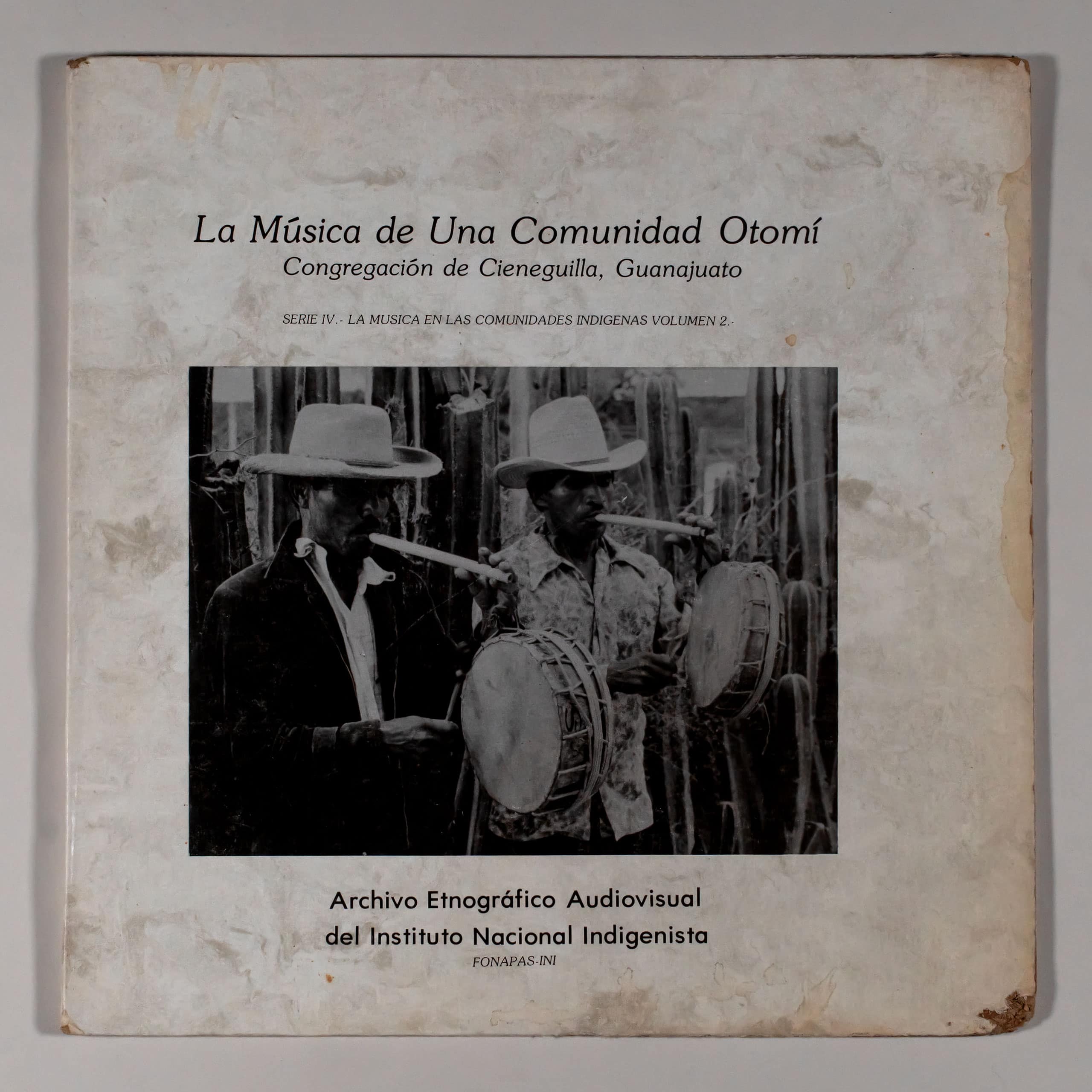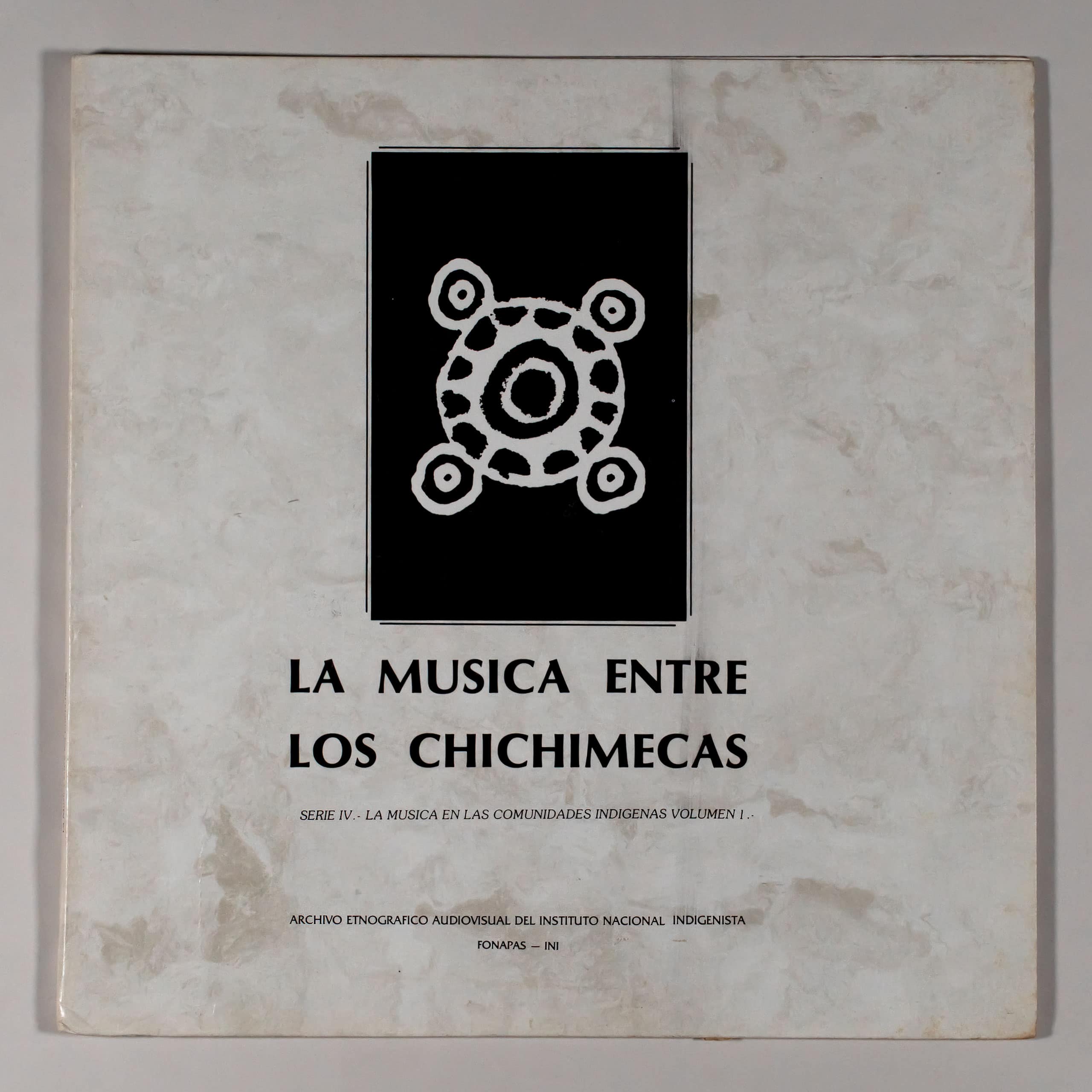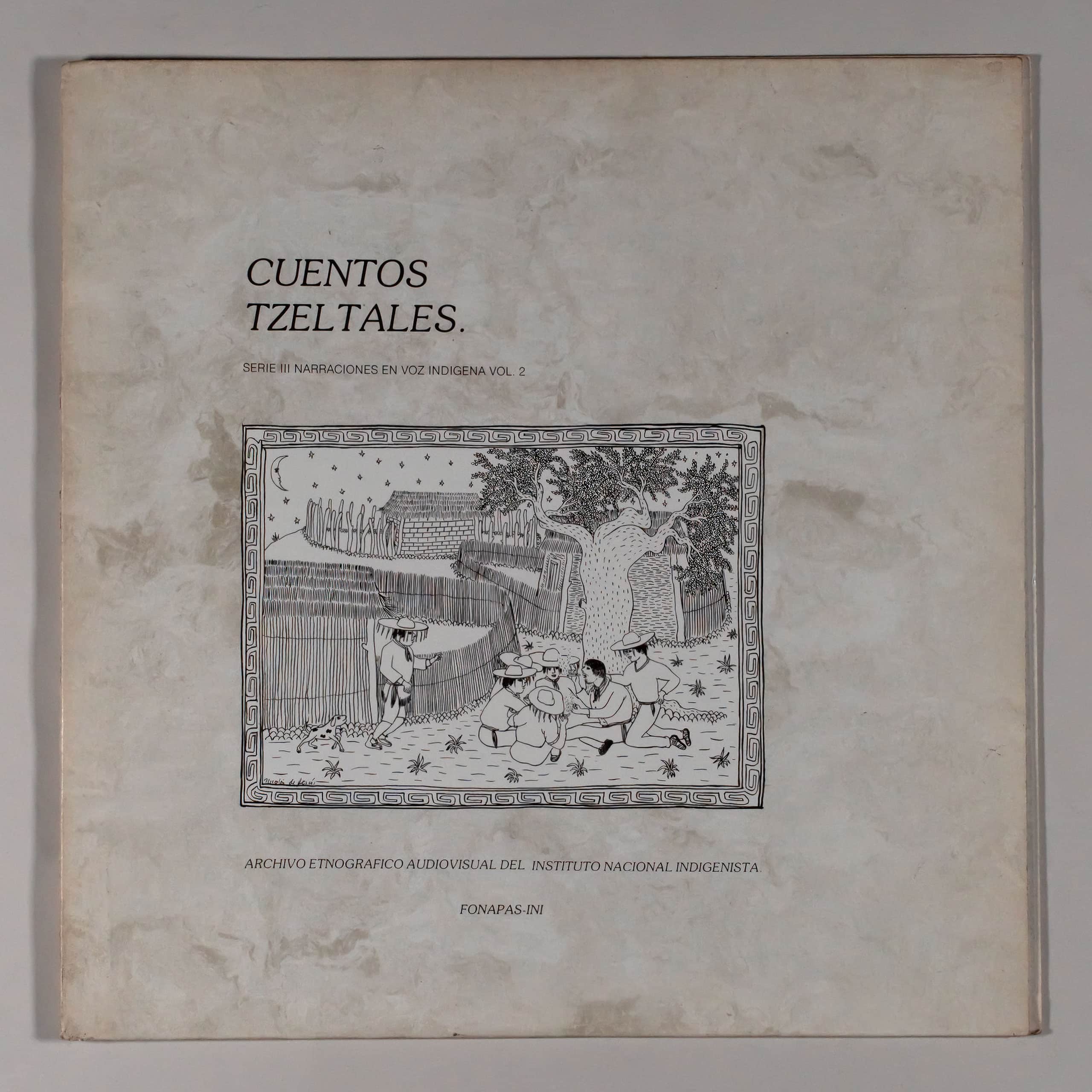SOUNDS AND TASTES OF THE HOT LAND OF GUERRERO
INAH SEP
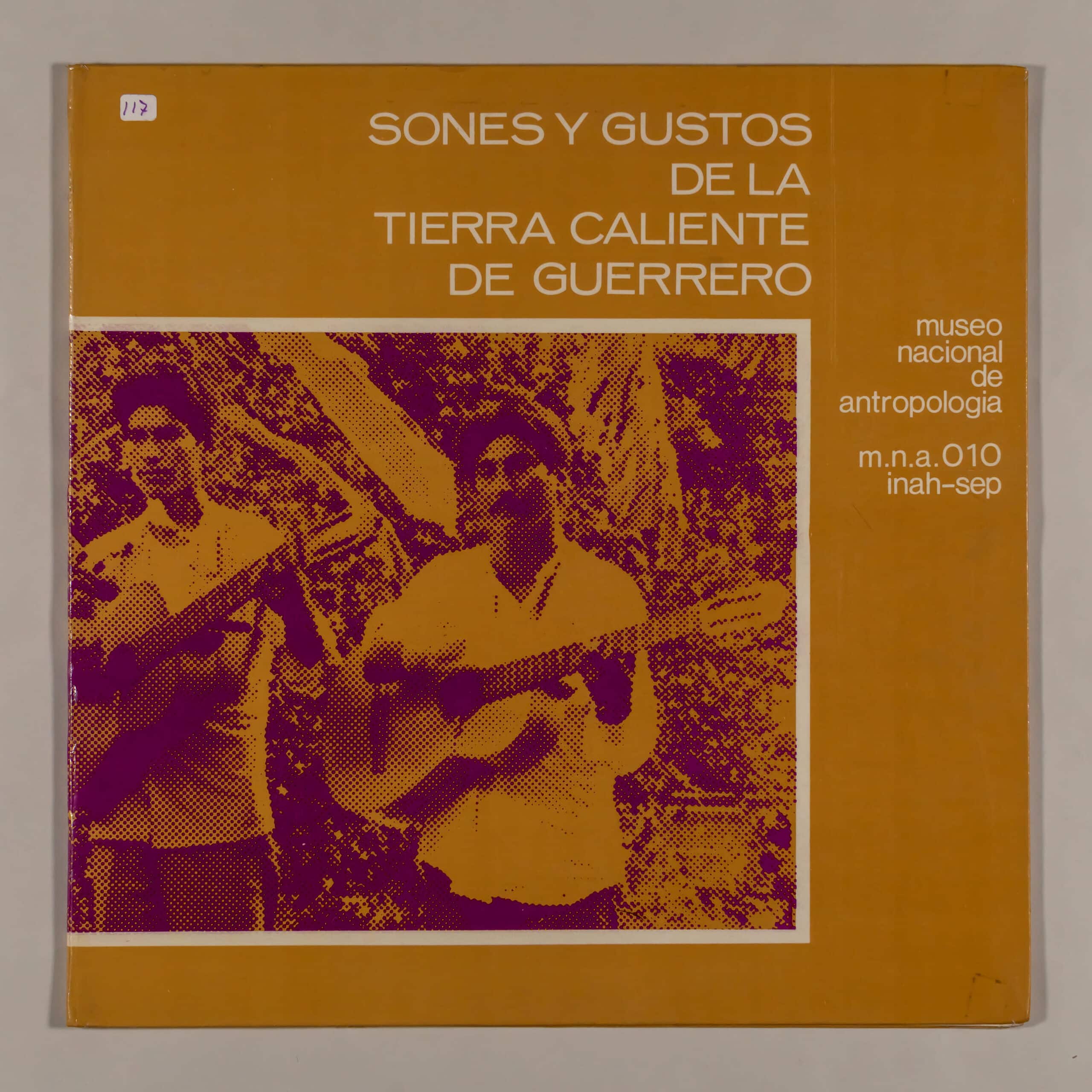
|
Label: INAH-SEP MNA-10, MC-0122 Released: 1971 |
Country: Mexico |
Info:
SOUNDS AND TASTES OF THE HOT LAND OF GUERRERO
THE REGION
The Balsas River runs boxed through almost its entire course. To the west of Iguala, the largest alluvial valley opens up along its path. The so-called Tierra Caliente, where Arcelia, Tlapehuala, Pungarabato, today Ciudad Altamirano, and Huetamo are located, is in the State of Michoacán, as the main towns. It is a low, dry and hot valley, barely three hundred meters above sea level, isolated by the walls of the Sierra Madre Occidental that the river excavates. It is occupied by a mostly mestizo population, by the remnants of the cuitlateco group and some Mexican enclaves. Until recently, they were dedicated to agriculture for consumption, regional ranching, extensive ranching and the exploitation of some gold placers that gave rise to many legends and goldsmithing. Today, with irrigation, commercial agriculture is introduced and communications are facilitated.
THE MUSICAL TRADITION
In the Tierra Caliente a characteristic musical tradition is practiced. Apparently it has a relatively recent origin. It arose from the model of the sonecito de la tierra, generalized throughout the country at the end of the 18th century as a festive and profane genre. Even today, the musicians who developed local forms are remembered, such as Juan Bartolo, who died in 1924, creator of many numbers in the repertoire and the last to use the harp, or Isaías Salmerón, who died twenty-five years ago, who recreated traditional sounds of different regions and incorporated them into the Tierra Caliente style. Even today he continues the creation process with pieces of descriptive and localist text.
Outside the Tierra Caliente, the style has spread to the south of the State of Mexico and exchanges elements with the tradition of the large harp ensemble from the Tierra Caliente of Michoacán that flourishes in the Tepalcatepec depression.
SET
The musical style of the Tierra Caliente is associated with a characteristic group that is made up of two violins, one or two sixth guitars and the small drum made of parota wood with a double head and of the military drum type. It is still possible to hear the potbellied six-string guitar that was part of the ensemble and that is sometimes replaced by a son abajeño guitarrón. The harp has ceased to be used since the times of Juan Bartolo. Except for the tamborita and the panzona guitar, which are locally made, the other instruments are made in Paracho on the Tarascan Plateau of the State of Michoacán.
THE TRADITIONAL REPERTOIRE
It is basically made up of two genres: taste and son, apparently derived from old sones and syrups. The taste is a little slower, always sung with lyrical or picaresque couplets. The son is faster and does not always have lyrics; when it has text its content is preferably picaresque. Both genders are danced by mixed couples; The very difficult zapateado is associated with the son. A good number of sounds and tastes refer to the livestock activity and its producers: the cuerudos, the cowboys who for certain tasks are covered with a kind of suede coat, and who sustain a particular tradition. Other sones refer to the environment, especially to fauna, and it can be assumed that they are the oldest, since at the beginning of the 19th century danceable sones were popularized with the name of animals, whose movements the dancers imitated.
The set apparently designed for these genres has assimilated genres of religious purpose, such as the vinuetes that are used to accompany solemn acts, and the wake pieces, slow waltzes that are played at wakes.
Also very popular is the corrido, a basically narrative genre, which is sometimes performed by the ensemble, but other times by a single musician accompanied by guitars.
THE INTERPRETERS
The musicians of the region are basically professionals, although not all of them are full-time, and they combine music with agricultural activity.
They are hired for various celebrations, especially of a family nature such as weddings and baptisms, which sometimes last up to three days. Other times they are hired to play at wakes or religious festivals. Previously they participated in the herraderos, festivals in which the tasks of gathering the cattle from the haciendas to mark or ship them culminated, and to which the splendor of the great performers must be attributed in part.
FACE A
1.–THE CALFER MAN – son
Taste of the variety that refers to the work in cattle ranch and its characters. This example was commercially popularized in the thirties, although dissociated from the set and even with a different rhythm. It is one of the favorite pieces of the local repertoire.
1)
Calfer man, calf man,
where did you leave the piales (repeat)
Ay, ay, ay, ay
at the pigpen door
they were all sane (repeat)
Chorus
I love you
because you are beautiful.
pink scented
I die for you (repeat)
2)
The bulls bellow above
downstairs they are listening. (repeat)
The caporal’s daughters
how good they are getting. (repeat)
Repeat the chorus
3)
The cuera made me angry
and I can’t soften it. (repeat)
I’m looking for a puddle
to put it to soak. (repeat)
Repeat the chorus
Performers: Ajuchitlán Ensemble: Anselmo Leandro, second violin, José Natividad Leandro, first violin, Santiago Leandro, guitar and first voice, Teodoro Leandro, guitar, Catarina Miranda, small drum and second voice.
2.–SON WITHOUT LETTER – son
These types of sones basically serve to accompany the zapateado. It is very likely that the son had the name of an animal, although its interpreters did not remember it. It is said that before, and in some rancherías even today, for the zapateado a wooden platform was made that rested on clay pitchers; A rope was placed on this, on which the dancer leaned, performing a tap dance barefoot that could be heard from several leagues.
Performers: Bardomiano Flores Ensemble: Bardomiano Flores, first violin, Juan Tavira, second violin, Salomón Echeverría, guitarrón, Artemio Díaz Calderón, guitar, Manuel Alonso, guitar, Martín Ruiz Lucián, drummer.
3.–ELENA’S CORRIDO
Traditional Spanish romance before the golden age. It presents a good number of variants in Mexico.
1)
Now I’m going to tell you
to honorable ladies:
do not give your arm to twist
when they are married.
2)
You see what happened to him
to the unhappy Elena:
she wanted to treat in latin
having the letter of her good of her.
3)
News of her had her husband
that Elena was her favorite,
her when she was alone
she from a french she was loved.
4)
A trip pretended her husband
to be able to find them,
catch them in bed
of her and be able to kill her.
5)
Open the door for me, Elena,
without any mistrust.
I am Fernando the French
I come from France.
6)
When Elena opened the door
their lamp went out.
They held hands
They went to the garden.
7)
Then she dressed her in white
how he knew how to dress her:
they laid a bed of flowers,
they went to sleep.
8)
That midnight,
Elena told him so
to Don Fernando the French:
why don’t you talk to me?
9)
Or have loves in France
or will want another more than me.
Don’t be afraid of my husband
that he is far from here.
10)
I have no love in France
I don’t want another one but you.
I’m not afraid of your husband
that he is next to you.
11)
Of what happened, happened,
We have something else to talk about:
commend your soul to God
because I’m going to kill you.
12)
Excuse me, dear husband,
pardon my misfortune.
Don’t do it so much for me
do it for my two creatures.
13)
Mercy, I entrust my children to you,
receive them as a mother.
If they ask you about Elena,
You tell them that you don’t know.
14)
If they keep asking you
you tell them I killed her,
I made her meat cecina
and I padded her legs.
15)
That midnight,
when the cylinder thundered,
what a misfortune of a woman,
she with three bullets she paid.
16)
Here they end up singing
problem verses.
Example for married women,
Have an example in Elena.
Performer: José Alonzo Lázaro.
4.–FUNERAL PIECE
This type of repertoire is performed at wakes. Formally it resembles the waltz, although the music of some corridos is also used. This genre does not include the tamborita or the song. As a hypothesis, it can be suggested that these pieces could be the remnant of an ancient wake tradition like the one practiced in other Latin American countries.
Performers: Ajuchitlan ensemble.
5.–THE LADYBUG – son
Attributed to Isaías Salmerón, but other versions of it are known in the country and especially in the Costa Chica of Guerrero, where it is sung in the form of a Chilean. This piece is also known in current Chilean folklore, where it possibly originated from Spanish models:
1)
Ladybug, remove, remove,
take me away from suffering
The time that I don’t see you
crazy I want to go back. (repeat)
Chorus:
Oh, what do I give him, what do I give him,
we’ll see,
Let’s see how the water runs
Let’s see her run.
Oh, what do I give him, what do I give him,
the water that spills
it is not picked up again.
2)
Ladybug, remove, remove,
take me away from walking in sorrows.
under your shawl
I’ll have a good night. (repeat)
Repeat the chorus
3)
Morning light,
of the bright morning.
If you knew my life
how much i love you (repeat)
Repeat the chorus
6.–THE HUACO – son
The kind that bears the name of an animal. In this case, the violins imitate the cry of the bird that gives the son its name. It is also said that the dancers imitate the movements of the bird in their dance. This type of sones appears documented in the archives of the Inquisition, which considers the movements and intention to be lascivious.
Performers: Ajuchitlán ensemble.
FACE B
1.–SAINT AUGUSTINE
Due to Juan Bartolo Tavira, the almost legendary composer of Corral Falso, very close to Tlapehuala. It is perhaps an enumeration corrido, in which the regional animals participating in a heradero party are humorously included, which ends with the intervention of the escort to silence a lawsuit initiated by the jejen and the corupo. Complete is not included.
1)
Saint Augustine victorious,
Saint Vincent and Saint Joachim,
they spoke of a blacksmith.
Saint Augustine told them:
I have one thing in mind
through God first,
to make a good blacksmith
and an exquisite party;
I have very shiny crockery
for a whole cirianera,
I have very good pots
of gourds and copal,
where should i cook
very delicious meals
of paitas and chuparrosas,
of auras and buzzards,
of cuijes and owls,
very favorite food…
oh, oh, ..
2)
Very favorite food
I have to celebrate
I must also kill
boars and skunks,
opossums and armadillos
instead of fat pigs,
and make deaf tamales
to give breakfast,
with none left
of all my vaquerada.
people are invited
for Sunday afternoon
eve of the bullfight,
night of the nixtamales…
oh, oh,…
3)
Night of the nixtamales,
Monday morning
the foremen will leave
to make the first sale
with all caution;
let there not be a mouse left;
snakes and vermin,
viper and scorpion,
and also the chameleon,
the ant and the cicada.
sitting with my guitar
I have to wake up singing,
then I’ll keep looking
the toroscos and cocones,
I bring the Seven Nations
through Veracruz and Havana,
oh, oh,…
Performers: Bardomiano Flores Ensemble. Solomon Echeverria sings.
2.–THE DEVIL – son
They are of zapateado dance. In these sones the tamborita acquires special importance, since it marks and adorns the rhythm performed by the dancer.
Performers: Ajuchitlán ensemble.
3.–THE CRESS – taste
Due to Isaías Salmerón, although it includes traditional verses recorded in other regions.
1)
At the foot of a green cress
where I met your love (repeat)
that I twist, that I twist,
oh, I already, I already sprained.
Now how do I untwist
hugging me from you (bis)
2)
I told a shorty
to wash my cloth (repeat)
Oh, the damn thing told me:
If you want, I even bathe it.
come in the morning
because it hurts him in the afternoon (bis)
3)
I have a crystal niche
made with my own hands, (repeat)
where should i put you
if we continue as we are,
but if you pay me wrong,
Well, even the niche we broke (bis)
Performers: Bardomiano Flores Ensemble.
4.–HOW DO YOU WANT A LIGHT – taste
Taste of traditional type and with hummed chorus. It resembles the sounds of the tirana of the Costa Chico de Guerrero and the Tehuantepec area.
1)
How do you want a light
light up two rooms. (repeat)
How do you want me to want
two hearts at once (repeat)
Zira, ra…
2)
How do you want to compare
a puddle with a fountain
the puddle will dry up,
our love is pending. (repeat)
Zira, ra…
3)
How do you want me to see you
on a radio date
and I am full of pleasures
hesitating through the streets. (repeat).
Zira, za…
Performers: Ajuchitlán ensemble.
5.–THE TORTOLITA – son
Because of Juan Bartolo. It also includes couplets that are sung in other regions. It is perhaps the most popular son in the Tierra Caliente of Guerrero.
1)
Lively dove (bis)
that I took you out of the nest (Bis)
lively dove.
Samuel was left crying (bis)
as he cries for you. (Bis)
Chorus:
Chole, Cholita, my life,
we go to mass at the Company,
I would like you to join
your little mouth with mine
so that you could kiss me
little mouth of Alexandria
So so
Who knocks on the door?
so so
I’m going to open it
so so,
I’m going to open it
so so,
let me sleep.
2)
Tortolita I would like (bis)
make a deal with you, (bis)
turtledove I would like
that you were my wife (bis)
and I was your husband. (Bis)
Repeat the chorus
3)
Tortolita why are you crying, (bis)
tell me who died (bis)
turtledove why are you crying,
if your lover died (bis)
Don’t cry, here I am. (Bis)
Repeat the chorus
Performers: Bardomiano Flores Ensemble.
6.–MARIA CUMBE – son
One of the most complex and difficult songs from the Tierra Caliente repertoire. Other versions of this are also known in other areas. The recording conditions determined little intelligibility in the text.
1)
Maria Cumbé of my life
how are you, how are you doing, (repeat)
…
that you have no news (repeat)
and come on, hey, just like that
…
and come on, hey, just like that,
the dust already arrived,
oh, how beautiful is the world,
pity that I die,
oh, how nice it is to have
a header arm,
come on and come on…
2)
This is the Maria Cumbe,
the king of all sounds (repeat
… women,
… of the men,
when women want
They even ask where.
Come on, hey, just like that,
his whole life is his law (repeat)
…lettuce
from the heart of the maguey,
turning the chair
surely you even fly,
Come on and go….
3)
This is the Maria Cumbe
that sing down there (repeat
I also know how to sing
but with a lot of work. (repeat)
Come on, hey, just like that,
the whole life just. (repeats)
I am the collector
of the pretty girls,
but not all of them
nothing but the young girls,
come on and come on…
Performers: Ajuchitlán ensemble.
Arturo Warman.
SOUNDS AND TASTES OF THE HOT LAND OF GUERRERO
MNA-010
FACE A
1.–the calfer man
2.–they are without lyrics
3.–elena’s corrido
4.–funeral piece
5.–the ladybug
6.–the huaco
FACE B
1.–saint augustine
2.–the devil
3.–cress
4.–how do you want a light
5.–the turtle dove
6.–maria cumbe
Recording and notes by Arturo Warman.
Mexico, 1971. ©
Secretary of Public Education,
engineer Víctor Bravo Ahúja;
Undersecretary of Popular Culture,
doctor Gonzalo Aguirre Beltrán;
National Institute of Anthropology and History,
architect Luis Ortiz Macedo;
Anthropology National Museum,
Dr. Ignacio Bernal;
Educational Services Section,
Professor Ma. Cristina S. de Bonfil.
THE DISC IS CULTURE
PRINTED IN MEXICO BY
SIGNS OF MEXICO, S.A. DE C.V.
Tracklist:
SOUNDS AND TASTES OF THE HOT LAND OF GUERRERO
SIDE 1
- A1 The calfer man –taste–.
Performers: “Ajuchitlán” Ensemble. Anselmo Leandro, second violin; José Natividad Leandro, first violin; Santiago Leandro, guitar and first voice; Teodoro Leandro, guitar; Catarino Miranda, small drum and second voice. - A2 They are without a letter –son–.
Performers: Ensemble “De Bardomiano Flores”. Bardomiano Flores, first violin; Juan Tavira, second violin; Salomón Echeverría, guitarrón; Artemio Díaz Calderón, guitar; Manuel Alonso, guitar, Martín Ruiz Lucián, drummer. - A3 Elena’s corrido. –corrido–.
Performers: “Ajuchitlán” Ensemble. Anselmo Leandro, second violin; José Natividad Leandro, first violin; Santiago Leandro, guitar and first voice; Teodoro Leandro, guitar; Catarino Miranda, small drum and second voice. - A4 Funeral piece.
Performers: “Ajuchitlán” Ensemble. Anselmo Leandro, second violin; José Natividad Leandro, first violin; Santiago Leandro, guitar and first voice; Teodoro Leandro, guitar; Catarino Miranda, small drum and second voice. - A5 The ladybug –taste–.
Performers: “Ajuchitlán” Ensemble. Anselmo Leandro, second violin; José Natividad Leandro, first violin; Santiago Leandro, guitar and first voice; Teodoro Leandro, guitar; Catarino Miranda, small drum and second voice. - A6 The Huaco –taste–.
Performers: “Ajuchitlán” Ensemble. Anselmo Leandro, second violin; José Natividad Leandro, first violin; Santiago Leandro, guitar and first voice; Teodoro Leandro, guitar; Catarino Miranda, small drum and second voice.
SIDE 2
- B1 Saint Augustine.
Performers: Ensemble “De Bardomiano Flores”. Bardomiano Flores, first violin; Juan Tavira, second violin; Salomón Echeverría, guitarrón; Artemio Díaz Calderón, guitar; Manuel Alonso, guitar, Martín Ruiz Lucián, drummer. Solomon Echeverria sings. - B2 The devil –taste–.
Performers: “Ajuchitlán” Ensemble. Anselmo Leandro, second violin; José Natividad Leandro, first violin; Santiago Leandro, guitar and first voice; Teodoro Leandro, guitar; Catarino Miranda, small drum and second voice. - B3 Cress –taste–.
Performers: Ensemble “De Bardomiano Flores”. Bardomiano Flores, first violin; Juan Tavira, second violin; Salomón Echeverría, guitarrón; Artemio Díaz Calderón, guitar; Manuel Alonso, guitar, Martín Ruiz Lucián, drummer. - B4 How do you want a light –taste–.
Performers: “Ajuchitlán” Ensemble. Anselmo Leandro, second violin; José Natividad Leandro, first violin; Santiago Leandro, guitar and first voice; Teodoro Leandro, guitar; Catarino Miranda, small drum and second voice. - B5 The turtledove –they are–.
Performers: Ensemble “De Bardomiano Flores”. Bardomiano Flores, first violin; Juan Tavira, second violin; Salomón Echeverría, guitarrón; Artemio Díaz Calderón, guitar; Manuel Alonso, guitar, Martín Ruiz Lucián, drummer. - B6 Maria Cumbé –son–.
Performers: “Ajuchitlán” Ensemble. Anselmo Leandro, second violin; José Natividad Leandro, first violin; Santiago Leandro, guitar and first voice; Teodoro Leandro, guitar; Catarino Miranda, small drum and second voice.
Credits:
Arturo WARMAN
Secretary of Public Education,
engineer Víctor Bravo Ahúja;
Undersecretary of Popular Culture,
doctor Gonzalo Aguirre Beltrán;
National Institute of Anthropology and History,
architect Luis Ortiz Macedo;
Anthropology National Museum,
Dr. Ignacio Bernal;
Educational Services Section,
Professor Ma. Cristina S. de Bonfil.
Arturo Warman: Engraver, Adjunct Material Writer
Victor Acevedo Martínez: Editor
Martín Audelo Chícharo: Editor
Guadalupe Loyola Zárate: Editor
Benjamín Muratalla: Editor, Director
Irene Vázquez Valle: Editor
H. Alejandro Castellanos Garrido: Editor, Researcher
Gabriela González Sánchez: Editor
Jazmín Rangel Evaristo: Editor
Guillermo Pous Navarro
Alfredo Huertero Casarrubias: Illustrator
Guillermo Santana Ramírez: Designer
Ajuchitlán Ensemble: Musician
Bardomiano Flores Ensemble: Musician
José Alonso Lázaro: Musician
Salomón Echeverría: Musician
Notes:
Recording and notes by Arturo Warman.
Mexico, 1971.
